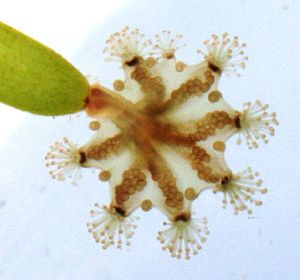Haootia
| Haootia | ||||
|---|---|---|---|---|

Artistic reconstruction of Haootia |
||||
| Temporal occurrence | ||||
| Ediacarium | ||||
| 560 million years | ||||
| Locations | ||||
|
||||
| Systematics | ||||
|
||||
| Scientific name | ||||
| Haootia | ||||
| Liu , Matthews , Menon , McIlroy and Brasier , 2014 | ||||
| species | ||||
|
||||
Haootia is an extinct animal species of uncertain taxonomic classification that lived in the Ediacarium . Her muscles may be visiblefor the first time.
etymology
The generic name Haootia comes from the Beothuk language . The word Haoot means demon - alluding to the somewhat terrifying appearance of the fossil. The species name quadriformis consists - in view of the quad symmetry - from the Latin words quadri (of quadrus, -a, -um or quattuor = four) and formis (Forma = form, shape, figure) together.
Discovery and first description
Haootia quadriformis was founded in 2008 by Martin Brasier ( University of Oxford ) in the turbiditic lower Fermeuse lineup ( Saint John's Group discovered). The type locality is Back Cove , located on the Bonavista Peninsula in Newfoundland . Only a plaster cast was taken as local law prohibited removal of the original. This is now kept in the collection of the Oxford University Museum of Natural History . The holotype is still on the north coast of Back Cove, about 1.8 kilometers north-northwest of Melrose . (Note: The fossil has since been recovered and is now kept in The Rooms Provincial Museum in St. John's )
A second, less complete specimen was found in the Trepassey Formation at Burnt Point on the Bonavista Peninsula.
The first scientific description of the fossil was in 2014 by Liu, Matthews, Menon, McIlroy and Brasier.
description
Haootia quadriformis differs fundamentally from all previously known fossils of the Ediacarian, as it has bundled tissue fibers that are interpreted as muscle tissue . The entire organism is dominated by a four-fold symmetry. Its blueprint therefore largely corresponds to the key characteristics of modern cnidarians (Cnidaria). The soft body organism has a circular adhesive disc at its base, which is connected to the four-sided main body by a relatively short stem. The size of the adhesive disc is 56 × 37 millimeters (the deviation from the circular shape is explained by the tectonic deformation of the sediment). Apart from a few concentric rings on the edge, the disc is smooth. In its center rises a starting point with several, closely spaced rings. The neck structure measures 9 millimeters in diameter. Above this is a 7 millimeter wide and 32 millimeter long handle that rises to the center of the four-sided main body.
The main body is compacted into a 49 × 72 millimeter rectangle and is made up of a multitude of parallel bundles of tissue that connect opposite corners. The individual fibers are between 100 and 600 μm wide and are 0.2 to 1.0 millimeters apart. They show fine lineations and are structured into bundles and parallel strands. The strands can occasionally split again, only to grow back together a little more. The fibers unite at the four corners to form upward striving, splitting main strands that split again shortly before their end. The fact that the main strands were flexible can be seen from changes in direction of up to 180 ° (in the direction of flow) and twists.
Smaller, branching strands also extend from the sides of the square body located between the corners.
Habitat and way of life
Haootia was probably an epibenthic organism that fed on organic suspension .
Taxonomic position
Haootia is generally regarded as a polyp belonging to the cnidarian tribe due to its symmetry and muscle structures , but no further classification is possible. Miranda and colleagues (2015) recently beat a morphological affinity to the benthic living stauromedusae before (Staurozoa). A recent example with a very similar blueprint is Lucernaria quadricornis .
Dating
The Newfoundland formations where Haootia occurs are estimated to be around 560 million years old BP .
meaning
Haootia quadriformis possibly documents the first appearance of muscle tissue in the fossil record and would therefore be the oldest known representative of the Eumetazoa . The oldest known muscle tissues to date come from the Lower Cambrian (arthropods of the Sirius Passet faunal community and vertebrates from southern China).
Individual evidence
- ↑ a b c Liu, AG, Matthews, JJ, Menon, LR, McIlroy, D. and Brasier, MD: Haootia quadriformis n. Gen., N. Sp., Interpreted as a muscular cnidarian impression from the Late Ediacaran period (approx . 560 Ma) . In: Proceedings of the Royal Society B: Biological Sciences . tape 281 (1793) , 2014, pp. 20141202 , doi : 10.1098 / rspb.2014.1202 .
- ↑ Miranda, LS, Collins, AG and Marques, AC: Is Haootia quadriformis related to extant Staurozoa (Cnidaria)? Evidence from the muscular system reconsidered . In: Proceedings of the Royal Society B: Biological Sciences . tape 282 , 2015, p. 20142396 , doi : 10.1098 / rspb.2014.2396 .
- ↑ Budd, GE: Stem group arthropods from the Lower Cambrian Sirius Passet fauna of North Greenland . In: Fortey, RA and Thomas, RH (Eds.): Arthropod relationships . Springer, Dordrecht, The Netherlands 1998, pp. 125-138 .
- ^ Shu, DG et al.: Lower Cambrian vertebrates from South China . In: Nature . tape 402 , 1999, pp. 42-46 , doi : 10.1038 / 46965 .
